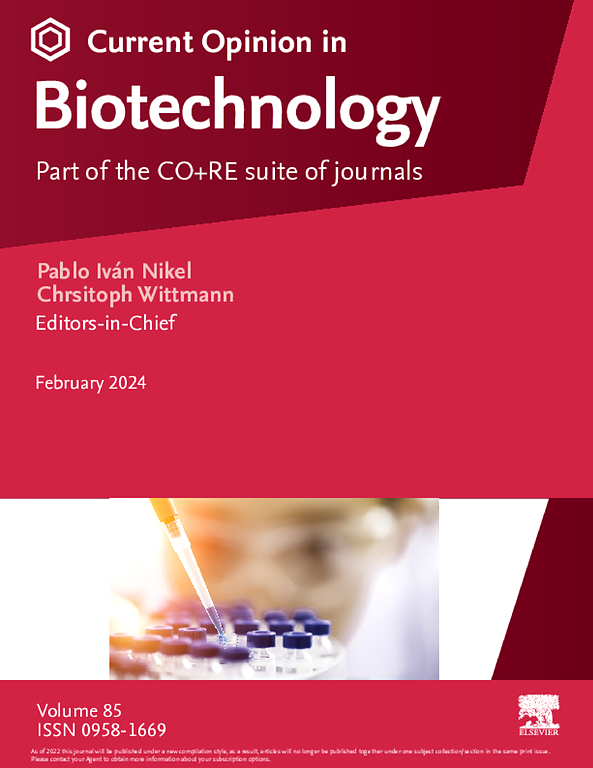优化Cupriavidus necator H16作为好氧C1转化宿主
IF 7.1
2区 工程技术
Q1 BIOCHEMICAL RESEARCH METHODS
引用次数: 0
摘要
能够转化二氧化碳或二氧化碳衍生的单碳(C1)化合物的生物系统可用于减少或逆转碳排放,同时建立循环生物经济,为人类依赖的燃料、食物和材料提供可持续来源。强大的生物经济将依赖于能够吸收C1化合物并将其转化为工业规模有价值产品的各种微生物。厌氧微生物是生产短链酸和醇的理想宿主,而能够进行有氧呼吸的微生物则非常适合高分子量产物的生物合成。其中一种生物是革兰氏阴性土壤细菌铜杆菌,它已经在生物聚合物的商业生产中使用了几十年。最近,它在二氧化碳上强劲的有氧生长能力激发了研究工作,使其成为基于c1的生物制造的主要细菌宿主之一。这篇综述强调了在历史上使C. necator成为工业生物转化过程的优秀宿主的特征背景下所做的努力:它的代谢通用性,快速生长到高细胞密度的能力,以及遗传适应性。本文章由计算机程序翻译,如有差异,请以英文原文为准。
Optimizing Cupriavidus necator H16 as a host for aerobic C1 conversion
Biological systems capable of converting CO2 or CO2-derived, single-carbon (C1) compounds can be used to reduce or reverse carbon emissions while establishing a circular bioeconomy to provide sustainable sources of the fuels, foods, and materials humanity relies on. A robust bioeconomy will rely upon a variety of microorganisms capable of assimilating C1 compounds and converting them to valuable products at industrial scale. While anaerobic microbes are ideal hosts for production of short-chain acids and alcohols, microbes capable of aerobic respiration are well suited for biosynthesis of higher molecular weight products. One such organism is the gram-negative soil bacterium Cupriavidus necator, which has been utilized in commercial production of biopolymers for decades. More recently, its capability of robust, aerobic growth on CO2 has inspired research efforts that have advanced it toward becoming one of the leading bacterial hosts for C1-based biomanufacturing. This review highlights those efforts in the context of the characteristics that have historically made C. necator an excellent host for industrial bioconversion processes: its metabolic versatility, ability to grow rapidly to high cell densities, and genetic amenability.
求助全文
通过发布文献求助,成功后即可免费获取论文全文。
去求助
来源期刊

Current opinion in biotechnology
工程技术-生化研究方法
CiteScore
16.20
自引率
2.60%
发文量
226
审稿时长
4-8 weeks
期刊介绍:
Current Opinion in Biotechnology (COBIOT) is renowned for publishing authoritative, comprehensive, and systematic reviews. By offering clear and readable syntheses of current advances in biotechnology, COBIOT assists specialists in staying updated on the latest developments in the field. Expert authors annotate the most noteworthy papers from the vast array of information available today, providing readers with valuable insights and saving them time.
As part of the Current Opinion and Research (CO+RE) suite of journals, COBIOT is accompanied by the open-access primary research journal, Current Research in Biotechnology (CRBIOT). Leveraging the editorial excellence, high impact, and global reach of the Current Opinion legacy, CO+RE journals ensure they are widely read resources integral to scientists' workflows.
COBIOT is organized into themed sections, each reviewed once a year. These themes cover various areas of biotechnology, including analytical biotechnology, plant biotechnology, food biotechnology, energy biotechnology, environmental biotechnology, systems biology, nanobiotechnology, tissue, cell, and pathway engineering, chemical biotechnology, and pharmaceutical biotechnology.
 求助内容:
求助内容: 应助结果提醒方式:
应助结果提醒方式:


